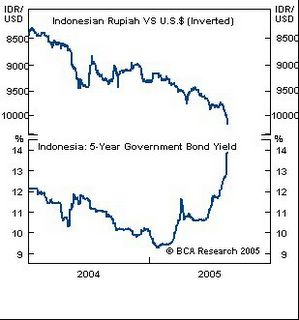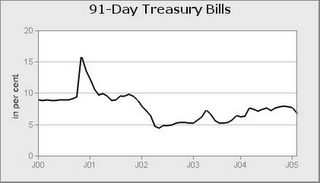``The government consists of a gang of men exactly like you and me. They have, taking one with another, no special talent for the business of government; they have only a talent for getting and holding office. Their principal device to that end is to search out groups who pant and pine for something they can't get and to promise to give it to them. Nine times out of ten that promise is worth nothing. The tenth time is made good by looting A to satisfy B. In other words, government is a broker in pillage, and every election is sort of an advance auction sale of stolen goods." -- H.L. Mencken Henry Louis Mencken (1880–1956), better known as "H.L. Mencken," 20th century journalist, social critic, a true cynic and freethinker, known as the "Sage of Baltimore."
I am disinclined towards making local political views, analysis or projections, however, when politics becomes a predominant factor in the directional flows of the market, it would be best for us to ruminate on the possible ramifications of the present developments.
The closure of the impeachment proceedings in the House of Congress has left as the only option the extra-constitutional measures to address the legitimacy concerns of the incumbent President. This had been seen with the present calls for military intervention by no less than Former Defense Secretary Renato De Villa, Senator Biazon, Senator Magsaysay and dismayingly my alma mater’s Br. Armin Luistro, FSC, president of the De La Salle University System.
While I am sympathetic to the cause (see July 4 to July 8th, ``Denouement of the Political Tele-Novela?”), I see the thrust to involve the military in politics as fraught with unintended consequences. I would rather argue on the merits of a regime change via the parliamentary method than a military led junta. Nonetheless it is rather odd, if not callow, to see those opposed to the parliamentary model as advocating for the unelected military regime paragon.
The fundamental problem with this approach is that these unwitting conjurers of regime change via military intervention anticipate that once men in uniform or the ‘intervenors’ move, these political mouthpieces would be the recipient of the wrested power, as had been the case in EDSA I and EDSA II. No one amongst them has ever thought of what would happen if the military decides to usurp power UPON THEMSELVES and/or if the military happens to confront its own shadows...violently!
Like most investors who are glued to the recent past events in gauging the possible outcome or the ``rear view mirror syndrome”, the politicians and their klutz followers believe or hastily presume that a peaceful transition would automatically be the end result of any military led upheaval. In short they are guilty of oversimplifying the causalities of a possible military adventurism.
However, if there are any clues to the mindsets of those aspiring to institute a `new order’, the recent call by a clandestine group or the Young Officers Union of the new generation (YOUng) should serve as a stern warning!
The covert group allegedly would end ‘elite rule and punish all corrupt and cheating officials in government. (So this unelected and unaccountable group will arbitrarily determine who is corrupt and elite by their own measure as the prosecutor, judge and the executioner?!)
According to a published statement, covered by the Philippine Daily Inquirer, by a certain officer whose pseudonym is Lieutenant Colonenl Arsenio Alcantara, ``The new system shall be a total overhaul and encourage genuine nationalists and not the blabbering politicians whose unprincipled and shifting loyalties, like the opportunists ilustrados and traitors in the past, make our present political set-up unstable; a system that shall prevent political dynasties who behave like kings and queens in their own local kingdoms and treat their constituents as their slaves."
Are we so desperate as to be willing to sacrifice ourselves and our families to sanctimonious and messianic totalitarian/fascists regimes which eventually would end up being another `cure worse than the disease’? (Think
Has anyone ever thought of what would be the chances that military interventions would NOT end up in a violent or chaotic struggle such as a civil war? It appears that our collective memories have run very short (Think December 1989-Makati Coup)! And that emotion has gotten the better over alot of us! Would our ‘military intervention’ advocates bear the responsibility of any attendant bloodshed once these fulminations turn into reality? Will they lay claim to blood spilled over their bare hands and knuckles? And over what principles as to justify such actions? Morality? On whose definition of morality; the communists or the facists or some ‘holier than thou’ preachers in between? Or for governments that continually does nothing but extort its constituents as HL Mencken describes above but fails to deliver its due services? (Think
As Bill Bonner and Addison Wiggins wrote in their book, Financial Day Reckoning (emphasis mine), ``In markets and in politics, he is a fool as often as not –driven by whatever emotion that has taken hold at that moment –fear, greed, wanton confidence, disgust, the desire for revenge, bonhomie...But markets and politics are even more subject to delirium because they involve large groups of people....The madness of crowds has two important features. First, crowds can only know things in their crudest, most dumbed-down form. Since truth is infinitely complex, it follows that what a crowd thinks is almost reduced to a point where it is more lie than truth. Second, though the same emotions beset individuals as well as crowds, a man on his own rarely causes much trouble. He is restrained by family, friends and the physical circumstances. A crowd on the other hand, so magnifies his emotions and so corrupts his ideas that soon the whole society is on the way to hell.”
Talking about the whole society on its way to hell (remember the proverbial saying ‘road to hell is paved with good intentions’), the recent pro-impeachment rally typifies what unholy alliances, clashing ideologues and sleeping with the enemy is all about. Former President Cory Aquino (to recall the same futile public march against the Senate’s Magnificent 12 against the US bases in September 1991), alongside with Susan Roces (widow of deceased presidential aspirant and famed actor FPJ), Senator Panfilo Lacson, communists and leftist advocates Crispin Beltran and Satur Ocampo smacks of these conflicting ideals and temporary yet brittle alliances. To aptly quote economist/TV host Winnie Monsod in her article `Strange bedfellows’ (emphasis mine), ``only the naive can hold the belief that the ouster of Ms Arroyo through people power would make the country better off. Getting into bed with a strange bedfellow in politics may lead to similar results as getting into bed with a strange bedfellow for sex: It may have fatal consequences.”
Finally, it is noteworthy to remark that the recent horse trading as a result of the impeachment proceedings may have reduced the odds of a political upheaval via PGMA’s possible surreptitious deals with former first Lady Imelda Marcos and former President Estrada.
While the former President Estrada representatives have denied it (6 were reported to have been absent during the impeachment proceedings while the wife of former Estrada stalwart and spokesman, Cong. Dilangalen voting an ABSTAIN (?!)), Congresswoman Imee Marcoses’ absence in the impeachment proceedings has this to say ``Don’t blame me for the failure of the opposition in this noble undertaking. I can no longer contribute anything more aside from my signing the [impeachment] complaint despite the tension that has existed between myself and my mother.” According to a report from the Philippine Daily Inquirer, ``Marcos added that it was common knowledge that former First Lady Imelda Marcos had long been supportive of Ms Arroyo.” Talk about political baggage and heavily compromised leadership.
Which leaves the ‘strange bedfellows’ alliance and some inexorable pharisaical, gullible and meddlesome members of the clergy and lay ministers and their halfwit supporters advocating and praying over for military adventurers to attain their warped versions of Utopia.
UGH.
``Those who cannot remember the past are condemned to repeat it." George Santayana, "The Life of Reason" (1905)











